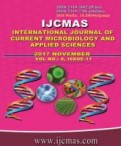


 National Academy of Agricultural Sciences (NAAS)
National Academy of Agricultural Sciences (NAAS)

|
PRINT ISSN : 2319-7692
Online ISSN : 2319-7706 Issues : 12 per year Publisher : Excellent Publishers Email : editorijcmas@gmail.com / submit@ijcmas.com Editor-in-chief: Dr.M.Prakash Index Copernicus ICV 2018: 95.39 NAAS RATING 2020: 5.38 |
A field experiment was conducted at the Adaptive Research Station, Sakhigopal, Puri during kharif-2012 to study the morpho-physiological basis of yield variation in the newly released rice genotypes. Nine rice genotypes such as Tanmayee, Mrunalini, Tejaswini, Swarna, OR-2327-23, OR-2324-8, Pratikhya, Hiranmayee and Swarna sub-1 were taken into test under shallow water depth condition in the field in a randomised block design (RBD) in three replications. In the present study, higher grain yield was obtained in Tanmayee due to more number of spikelet/panicle, ripened grain/panicle, less number of sterility percentage and total number of spikelet/panicle. On the contrary, lower value of the above characters reduced the grain yield in Swarna sub-1. The 1000-Grain weight was found to be maximum 26.4gm in Tanmayee and minimum value of the same was exhibited by Tejaswini (18.8gm). The number of chaffs/panicle was found to be minimum (9.1) in Swarna whereas, the maximum value of the same was observed in OR-2324-8 (12.7). Partitioning of photosynthates into grains as measured in terms of HI showed maximum value (36.2%) in Tanmayee which was significantly greater than Swarna sub-1, OR-2327-23 and OR-2324-8. On the other hand, Hiranmayee exhibited the minimum value of the same (32.5%) being at par with Swarna sub-1.
 |
 |
 |
 |
 |